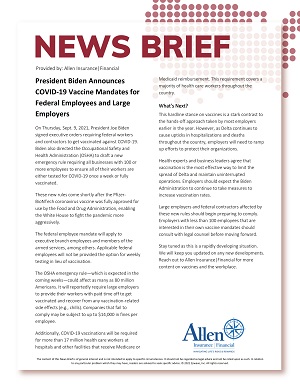A health reimbursement arrangement (HRA) is an employer-funded account that is designed to reimburse employees for qualified medical expenses that are paid for out-of-pocket. Additional information is on this “Knox Your Benefits” PDF.
The Top 6 Things to Know About Workers Compensation Insurance




By Karen Reed and
Krissy Campbell
1. Workers’ compensation insurance covers your employees’ medical expenses if they are injured on the job.
2. Workers’ compensation can reimburse the employee for their lost wages.
3. Workers’ compensation can provide disability benefits.
4. Maine law requires you to carry it.
5. Workers’ compensation can provide death benefits.
6. And the most important thing about workers compensation coverage? Having a knowledgeable local agent who can help you with managing the costs and your exposures.
When you have questions, Ask Allen. We’re here to help.
Commercial and Mixed-Use Real Estate
How to balance property owner’s dreams with insurance reality


Cale Pickford
By C ale Pickford
Originally submitted to Maine REALTOR Magazine
The effects of the COVID-19 pandemic have been far-reaching in all industries, but it seems clear that 2020 and 2021 have fundamentally changed the way business is conducted and, in turn, left an indelible mark on the commercial real estate market.
Demand for warehouses and distribution centers for e-commerce, self-storage facilities, affordable housing and certain retail spaces for grocery and pharmacy businesses is at an all-time high, while occupancy rates for hotels, retail, restaurant and traditional metro downtown office space have weakened significantly.
Many of these struggling sectors were buoyed by federal stimulus money, and many of the changes to the way people work will remain for the foreseeable future. The impact of this is being felt right here in the Pine Tree State.
Through both economic studies and anecdotal evidence, we know that Maine is getting a massive influx of new residents. Many are bringing their jobs with them and working remotely for employers elsewhere, while many others will be looking to start new small businesses in our state. Maine welcomes these entrepreneurs − but it is important that dreams intersect with reality before the purchase to bring about an understanding about how insurers look at mixed-use real estate. This knowledge can help you guide your clients in making a decision that will set them up for long-term success.
We can all agree that remote working is here to stay. While there is no question that many employees and business still find value in shared office space which facilitates professional and social interaction, it is clear that the idea that one has to be in a traditional office in order to be productive has been entirely debunked. As a client who recently moved from Massachusetts to Midcoast Maine told me, he could do his job from the moon if there was an Internet connection there.
For the most part, employees of larger companies who work from home do not have any unique insurance needs and a standard homeowner’s policy will accommodate their professional use of the home. However, it seems like an equal number of people are bringing their professional expertise to Maine and are looking to work as freelancers or consultants.
Depending on the business sector, these independent professionals need to insure their business in many of the same ways that larger companies do. As with remote employees, so long as they do not have client traffic or employees in their home, they often can rely on a traditional homeowner’s policy to insure their home, though it is important to note that that policy will still exclude any business property or liability exposure. In order to close that gap, these independent professionals will need to secure a commercial insurance package policy, which provides general liability, business personal property (think of that expensive laptop and Zoom lighting set up) and most importantly, professional or errors and omissions liability insurance. Knowing the costs of this insurance program up front is an important component of a sound business plan.
How about those occupations where business cannot be conducted via phone, email and Zoom? Maine has produced and attracted artisans and craftspeople for generations and many of these creative and skilled people take advantage of the low cost, short-commute synergy that home-based businesses provide.
As with work-from-home professionals, the unmodified homeowner’s policy excludes coverage for business activities and property. However, unlike use of a room at home for the new traditional office space, many other business activities will disqualify one from homeowner’s coverage altogether. In instances such as these, usually the home or outbuilding where business is conducted (i.e. where the product is made) will need to be insured on a commercial policy and then the owner needs to be insured as a tenant of the commercial building.
This kind of hybrid solution picks up the personal property and liability protection which is excluded on the commercial insurance policy. Examples of businesses which might compromise eligibility for homeowners programs would be woodworking, boat building, commercial food products manufacturing, ceramics manufacturing with kilns, farming, and many others.
Historians and economists suggest that the pandemic-inspired paradigm shift will propel Maine to a transformational chapter characterized by sharp gains in property values, a younger and growing population and economic growth. No doubt this current trend will continue, with many individuals and families making the leap of faith to move to Maine and following their dream. As a central advisor in that transition, make sure these dreamers and doers are considering all of the practical challenges that their move entails. And as always, a critical component of that advice is for your buyer to call a local independent insurance agent who understands your client’s dreams and can suggest insurance and risk management solutions that will protect their future.
Retirement Savings and Tax Legislation in the Pipeline
By Sarah Ruef-Lindquist, JD, CTFA


Sarah Ruef-Lindquist, JD, CTFA
Last October, I wrote about some of the changes possibly in store for individuals and their income taxes as 2021 approached. Now, a year later, we have a little bit better idea of what MIGHT be in store, but Congress has not yet submitted a bill for the president’s signature. There has also been some discussion and activity around further modification of laws for retirement savings in addition to those in the SECURE Act from 2019 that would impact how and when people save for retirement, and how those retirement funds are accessed.
We have had a House version and a Senate version produced on the tax laws, and here’s what I’m seeing for possible provisions, based on what I’m reading and hearing from folks in DC who focus on these developing issues:
• According to an article in Forbes [1], income tax rates will rise modestly, bringing individual tax rates to 39.6% for ordinary income for married individuals who file jointly with taxable income over $450,000, heads of household with taxable income over $425,000, and unmarried individuals with taxable income over $400,000.
• Maximum capital gains tax rates would also increase from 20% to 25%, for sales that occur on or after Sept. 13, 2021, and will also apply to Qualified Dividends. The present rate of 20% will continue to apply to any gains and losses incurred prior to September 13, 2021, as well as any gains that originate from transactions entered into under binding written contracts prior to September 13, 2021.
• For IRA owners with large IRAs, accounts that exceeds $10 million as of the end of a taxable year, no further contributions will be allowed if the owner has taxable income over $400,000, or married taxpayers filing jointly with taxable income over $450,000.These large IRA owners will be required to make a minimum distribution equal to “50% of the amount by which the individual’s prior year aggregate tradition IRA, Roth IRA, and defined contribution account balance exceeds the $10 million limit”. Even more extreme treatment will apply to those who have over $20,000,000 in combined accounts.
A “Secure 2.0” bill has some additional provisions for retirement accounts. According to www.benefitspro.com[2] , for those aged 62-64 with a 401(k), catch-up contributions would increase from $6,500 to $10,000. Similarly, for that same age bracket contributing to a SIMPLE IRA or Simplified Retirement Plan (SEP), catchups would increase from $3,000 to $5,000 per year.
Required Minimum Distributions (RMDs) are IRS-mandated amount of money that must be withdrawn from traditional IRAs or employer-sponsored retirement accounts each year. The current RMD start age is 72-years old, but this legislation would incrementally increase that age from 72- to 75-years old over the next ten years. A few extra years of tax-free appreciation and income could yield additional funds if the market does well.
• RMD 73 starting on Jan 1, 2022
• RMD 74 starting on Jan 1, 2029
• RMD 75 starting on Jan 1, 2032
The penalties for missing an RMD would also change. Currently, there is a 50% excise tax on withdrawals that do not occur within the specified window. SECURE 2.0 would reduce this penalty to 25%, and only 10% if corrected in a timely manner.
Finally, we wrote last year we were anticipating losing favorable tax treatment for inherited investments. Essentially, we were hearing that the long-standing “step-up in basis” was going away. This would mean that heirs would have to use the tax basis of their benefactor to calculate their own capital gain upon sale of these assets, rather than using the value on the date of the benefactor’s death for basis. This was the “step-up” we had come to use for many years to reduce the impact of capital gains on inheritances. The provision appears to be safe – for the time being – as its removal is not in the most recent versions of proposed legislation.
Be sure to check in with your financial and tax advisors about how these provisions may impact your tax or retirement savings situations. The final versions of the legislation may differ widely from what we have summarized above.
Sources:
Charitable Giving Opportunities for 2021


Sarah Ruef-Lindquist, JD, CTFA
By Sarah Ruef-Lindquist, JD, CTFA
As year-end approaches, many of us think about the charitable organizations that we have supported and want to continue supporting through annual giving. The tax advantage of making charitable gifts has changed dramatically in the past several years, and some opportunities exist that may not after the end of this year.
In recent years, the increased amount of the standard deduction has made itemizing charitable deductions less tax efficient. Because individual taxpayers have a standard deduction of $12,550 and married joint filers $25,100, often the combined value of itemized deductions, including charitable gifts, does not exceed those amounts. However, even non-itemizers can take advantage of the $300 for individual or $600 for married joint filer charitable deduction opportunity for 2021. This is an extension of the CARES Act of 2020.
The CARES act provision allowing cash contributions of up to 100% of AGI (Adjusted Gross Income) is also available for charitable giving in 2021 for itemizers. Gifts exceeding that amount may be carried over to future tax returns for up to 5 additional years. The CARES incentives are not available for gifts to donor-advised funds, supporting organizations or private foundations. This provision could increase the tax efficiency of large cash gifts that would otherwise be limited in their deductibility to 60% of AGI before or after the CARES act is effective.
A taxpayer who itemizes age 59 ½ or older can make a distribution from any defined contribution plan (401(k), IRA, 403(b)) and deduct up to 100% of AGI in 2021 under the extended provision of the CARES act. This could present a unique opportunity for many wishing to make a large gift to charity and use their retirement funds to do so.
And there are perennial gifting strategies that have tax efficiencies. One of these would be using appreciated stock instead of cash to make charitable gifts. 2021 saw record high market values for the stock market. The capital gains that are imbedded in these assets means that the full current market value of the stock can be a charitable gift without any capital gains tax being paid. The charity gets to realize the full value of these assets, while the donor does not recognize any capital gain when using them for charitable gifts.
Another option for those age 70 ½ or older involves IRA’s. Qualified Charitable Distribution (QCD) of up to $100,000 per year from IRA’s are extremely tax efficient. Not only can the distribution cover what would otherwise be considered a Required Minimum Distribution for those age 72 or older, but they are distributed directly to charity from an IRA without any income tax payable. Usually, distributions from an IRA require payment of income tax (federal and state, if applicable), but not so with QCD’s. For those who are less reliant on these funds from year to year, this is a particularly attractive option that involves giving the specific instructions to your IRA advisor or administrator to make the distribution.
As you consider any charitable giving for 2021, be sure to seek the advice of a professional financial or tax advisor to understand fully how any charitable gift can impact your particular financial and estate plans.
To Buy or Not to Buy . . . When Do You Need Life Insurance?
Whether you need life insurance depends partly on your stage of life. If you’re younger, you may have less need for coverage. As you move along the path in life, you’ll likely have more of a need. And, as your responsibilities lessen, your need may decrease.
Here’s a look at how your phase of life affects your life insurance needs.
Young and Single
As a young adult, you likely don’t depend on others for financial support. In most cases, your death wouldn’t create a financial hardship for others, making life insurance a low priority.
You could argue that you should buy now! The cost of life insurance factors in several things, including your health. At this point in your life, rates will probably be low. Now, while this may be a valid argument if you’re at higher risk for medical conditions (e.g., diabetes) later in life, for now, you may want to consider investing the money you’d spend on premiums.
Some exceptions to this include:
• You have a mortgage or other loans with a cosigner. Your death would leave them entirely responsible for the debt, so you may want insurance to cover this.
• You have a child or you’re supporting your parent/grandparent. As they depend on you, life insurance could provide support for them if you were to die.
Married . . . with Children (Or Without)
Married couples without children have little need for life insurance, especially if you both contribute equally to the household and don’t have a mortgage.
Once you buy a home, though, it’s a different story. Even if you both have well-paying jobs, the mortgage debt may be more than one person can handle on a single salary. And other debts, such as credit cards, can add to financial worries. In this situation, both of you should consider buying a modest amount of life insurance to provide financial support.
If you start a family, your life insurance needs are at their peak. In most cases, it’s appropriate for both parents to have life insurance.
If your family has a single income, it is completely dependent on that salary for financial security. In this case, both parents should carry enough life insurance to cover lost income or the economic value of lost services—like having to pay for childcare if the stay-at-home parent dies.
Dual-income families need life insurance, too, because it’s likely the surviving spouse will suffer financial hardship keeping up with household expenses and childcare costs.
Separation Anxiety
If you get a divorce, you’ll need to decide what to do about your life insurance, both from a beneficiary and coverage perspective. Add in dependents and it becomes more complex.
Keep it simple. If you don’t have children, it may be as simple as changing your beneficiary and adjusting your coverage.
Work it out. If you have children, the custodial and noncustodial parents will need to work out the details of your life insurance. You’ll want to make sure your children—and not your ex-spouse—are provided for in the event of your death. This may mean purchasing a new policy or changing the beneficiary to your children. If you and your ex-spouse can’t agree, the court will decide for you.
Climbing the “Corporate” Ladder
So, how do career changes affect your life insurance needs? It’s important to review your coverage whenever you leave your employer or start your own business.
When you leave your job, any employer-sponsored group life insurance coverage typically ends. Find out if you’ll be eligible for group coverage with your new employer or look into purchasing coverage yourself. You may also be able to convert your group coverage to an individual policy; it may be more expensive, but it’s a good choice if you have a preexisting medical condition that may prevent you from buying life insurance coverage elsewhere.
You should review your coverage amount, too. Your policy may no longer be adequate, especially if you’ve incurred more debt and expenses. If you own a business, consider your business debt. If your business isn’t incorporated, your family could be responsible for those bills if you die.
The Golden Years
Ah . . . retirement! Once you hit these golden years, your life insurance needs may change again. If fewer people depend on you financially, your debts have been paid, and you have substantial financial assets, you may need less coverage than before. But it’s possible that your life insurance needs will remain the same. The proceeds from your life insurance can be used to pay for your final expenses or to replace any lost income for your spouse (e.g., social security or a pension). Proceeds can even be used to pay estate taxes or as a charitable donation.
No matter what phase of life you’re in, it’s a good time to review your options and decide whether you need coverage and, if so, how much. If you’d like to discuss options, please reach out to me or my office.
This material has been provided for general informational purposes only and does not constitute either tax or legal advice. Although we go to great lengths to make sure our information is accurate and useful, we recommend you consult a tax preparer, professional tax advisor, or lawyer.


Commercial Hull Policy Coverage & Equipment On and Off Your Vessel
By Chris Richmond
Originally Submitted to WorkBoat Magazine
Your commercial hull policy provides coverage for more than just your hull. A policy may extend coverage to the “hull, tackle, apparel, engines, boilers, machinery, appurtenances, equipment, stores, boats and furniture.”
But what happens when you have a claim involving any one of these items? If the claim is covered, then you will first have to pay the deductible. Depending on the amount of hull coverage you have, this can be rather sizable and may well exceed the value of what was damaged. Let’s look at some ways to help improve your coverage
Do you have a tender? Have it listed separately on the policy with its own hull limit and a smaller deductible. The liability from your vessel still extends to the small boat but when the tender has its own hull value listed, you can have a much more manageable deductible. And don’t forget to tell your insurance agent when you buy a new outboard for the tender. This can greatly increase its value and quickly exceed the value for which you have insured the tender.
Do you store items ashore during the off season? Some policies will reduce the coverage on these items while off the boat by covering only claims based on fire. Be aware: Should an item be stolen then your boat’s policy will not react.
Have you installed special equipment on your vessel to perform specific work? They can be scheduled on your policy with a stated value along with an appropriate deductible.
Do you operate equipment overboard? Good luck getting that added to your commercial hull policy. If you have ROV units stored on board your boat you may be able have them scheduled on your hull policy but as soon as they go overboard coverage would cease. Obtaining a stand-alone policy specifically written to cover your ROVs is the proper way to provide coverage. This policy will react to claims from incidents both on the boat as well as in the water.
Take a moment to look at your boat and the equipment that you have on board, then give your insurance agent a call and discuss the current limits you for the vessel and everything on it, especially what can be stored (or is stored) on land. You will be happy you did should you need to file a claim.


President Biden Announces COVID-19 Vaccine Mandates for Federal Employees and Large Employers
On Thursday, Sept. 9, 2021, President Joe Biden signed executive orders requiring federal workers and contractors to get vaccinated against COVID-19. Biden also directed the Occupational Safety and Health Administration (OSHA) to draft a new emergency rule requiring all businesses with 100 or more employees to ensure all of their workers are either tested for COVID-19 once a week or fully vaccinated. This News Brief explains further.
Employee or Independent Contractor? It Makes a Difference!
By Sally Miles
Have you ever thought about the difference between an employee and independent contractor?
The answer can be found through a series of questions created by the Maine Department of Labor.
Paying someone using a 1099 not does automatically make them an independent contractor.
The facts of the relationship between the business and individual conducting work determine whether you have an employee or independent contractor.
When it comes to insurance, this distinction is important because a business’s payroll (the people who are true employees and not independent contractors) will impact both their workers compensation insurance and general liability insurance policies, in terms of both cost and risk exposure.
When you have questions, Ask Allen. We’re here to help.


Investor360° Security Enhancement: Multifactor Authentication Required on Sept. 9
A note to our financial planning clients:
To create a more secure login process in Investor360°®, multifactor authentication (MFA) will be required for all users (mobile and desktop platforms) beginning Sept. 9, 2021.
What Does This Mean?
When you log in after Sept. 9, you will be asked to set up MFA in Investor360° on either a desktop browser or mobile app. A set of instructions will appear on your desktop or mobile device screen to assist you with the setup process. We’re including a link here to the Investor360° Mobile Reference Guide.
Want to Download Investor360° Mobile?
On your mobile device, you can download Investor360° Mobile from the Apple Store or Google Play.
Questions?
If you have any questions or would like to give feedback about Investor360° MFA, please give us a call at 236-4311.


- « Previous Page
- 1
- …
- 18
- 19
- 20
- 21
- 22
- …
- 88
- Next Page »



